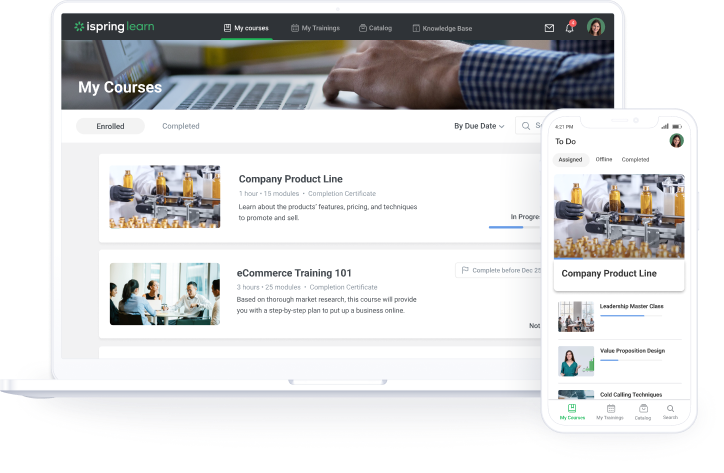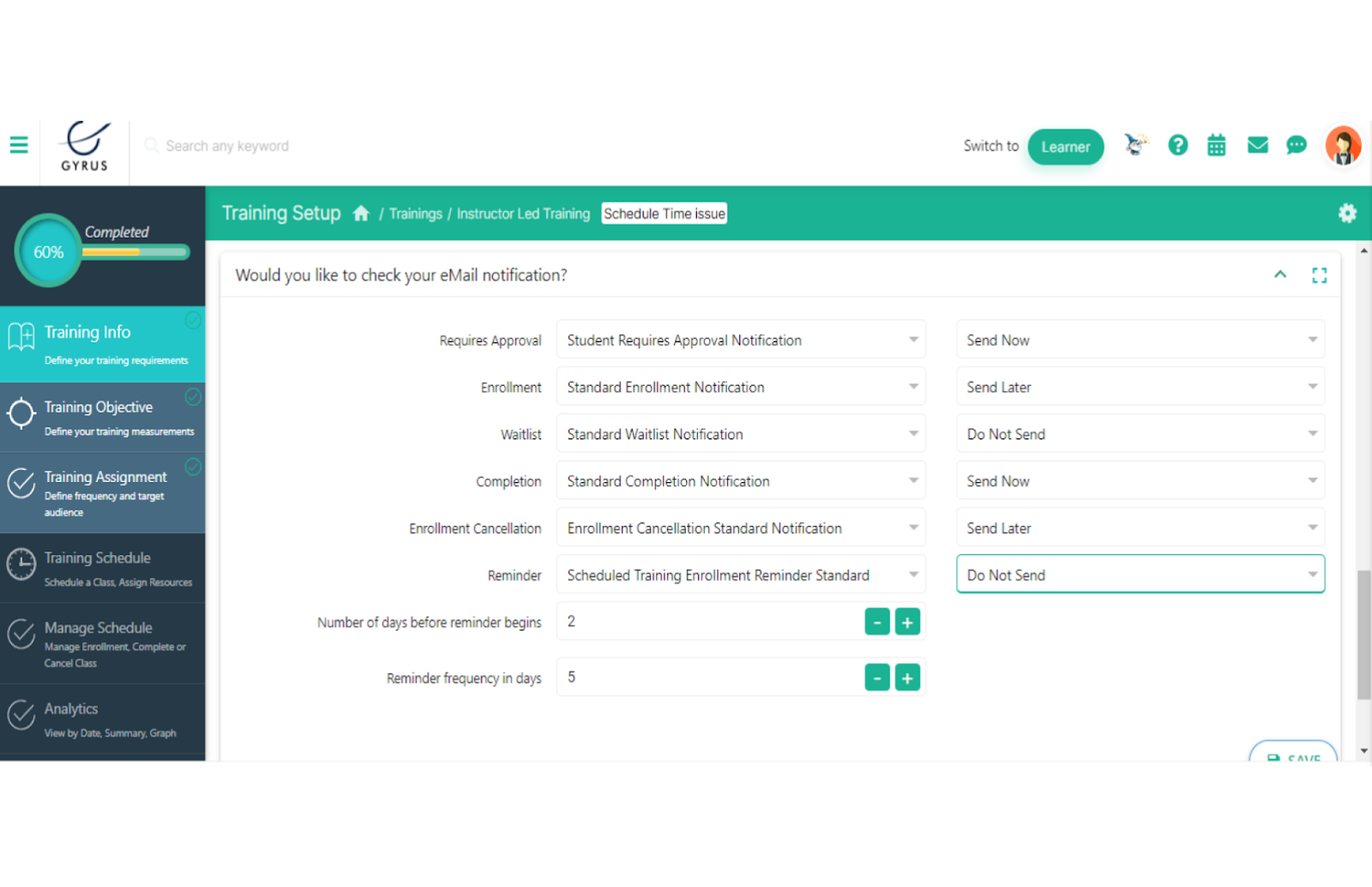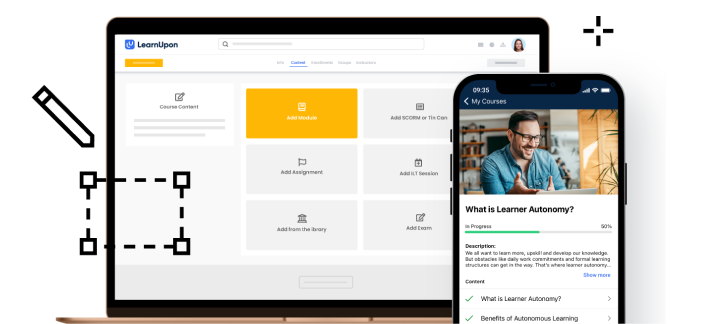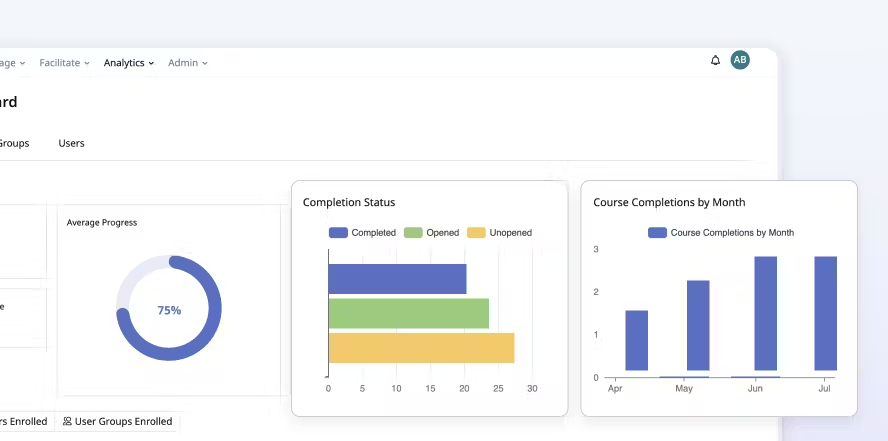The Top 5 Picks for a SaaS LMS to Consider in 2025

Are your learning systems outdated, clunky, and tedious to work with? Then, chances are, they fail to provide the level of employee engagement you’re aiming for. The good news is that the EdTech market offers lots of great alternatives to older tools.
Here, you can explore our top ten picks for SaaS education software providers that can boost your training and development initiatives and keep your teams engaged. Whether you’re familiar with SaaS LMSs or just planning to switch to a cloud-based solution, this article has everything you need to make the right choice.
| SaaS LMS | Key features |
| iSpring Learn | Native mobile app, 360-degree review, authoring tool |
| Nimble | Quick setup, simple built-in course creator |
| Gyrus LMS | Learner engagement features, data security |
| LearnUpon | AI-powered learning assistance |
| SC Training (previously known as EdApp) | Mobile learning, microlearning |
Differences Between a SaaS and a Hosted LMS
A SaaS LMS is a learning management system hosted in the cloud instead of a physical on-premise server. It means that all you need to use an LMS is a stable internet connection. Both admins and learners can access the platform anywhere, anytime, with ease.
A hosted learning management system (on-premise LMS) operates through a physical server. This is a more secure system, since its components are maintained and upgraded manually by an organization’s in-house IT team.
Here are the main differences between cloud-based SaaS LMSs and on-premise solutions:
| Feature | SaaS LMS | Hosted LMS |
| Installation | Requires hardware and software on the company server | Managed on cloud servers |
| Maintenance and updates | Manual updates and regular in-house maintenance are required | The LMS vendor handles updates and maintenance |
| Support | Limited support | Extensive support from the vendor |
LMS integration capabilities | Limited, unless there is extensive development | APIs for seamless integration with other systems |
| Scalability | Limited by hardware and software capacity | Easily scalable |
| Security | Company responsible for data security measures | The vendor ensures robust security protocols |
| Customization | Offers greater customization options | Varies, depending on the vendor |
| Cost | Higher upfront costs, ongoing maintenance expenses | Typically subscription-based, lower initial costs |
Benefits of a SaaS LMS
A SaaS learning platform provides multiple benefits that help implement an efficient corporate training program. These include:
- Immediate deployment. With SaaS LMSs, you can launch learning immediately and address any issues right away through tech support.
- Automated updates. A SaaS learning management system comes with regular updates across all active devices. This saves time and keeps the process hassle-free.
- Reduced total cost of ownership (TCO). A SaaS LMS helps reduce TCO by cutting down on maintenance costs and making the system more cost-effective.
- Integration capabilities. Organizations can benefit from integrations with third-party tools, such as HRIS, calendars, online conference platforms, and more.
Also read → How to choose an LMS system
The Top 5 Picks in SaaS Learning Management Systems to Consider
1. iSpring Learn
G2 rating: 4.5
iSpring Learn is a highly intuitive SaaS learning management system. It’s perfect for businesses or L&D departments looking for a one-stop solution for employee training. iSpring Learn comes equipped with extensive progress report and analytics capabilities, excellent collaboration features, and robust gamification mechanics to engage employees effectively.

What makes iSpring Learn stand out from many competitors is that a powerful yet easy-to-use authoring tool, iSpring Suite, comes bundled with it. This course building software allows users to create interactive eLearning courses in a familiar PowerPoint interface or build beautiful page-like learning content in a browser-based Page tool.
iSpring guarantees 100% data security. You can store all your training assets safely in dedicated cloud storage, control access levels, and handle sensitive data without any risk of leaks. The LMS also comes with a native mobile app that allows learners to access courses offline.
Key features
- Intuitive interface
- Comprehensive and insightful reports
- SCORM-compliant
- A native mobile app with offline learning
- Off-the-shelf courses
- World-class tech support
- Multiple integrations
- 360-degree review
Why consider: It’s a reliable, comprehensive LMS suitable for both small teams and large enterprises. With a minimal learning curve, you can deploy the tool in less than a day and launch results-driven training instantly.
Price: Starts at $3.75 per user, per month, billed annually.
2. Nimble
G2 rating: 4.5
Nimble is a simple, yet feature-rich SaaS LMS. It offers admin-friendly features that help deliver courses and track employee progress and performance. Nimble has all the essential features you might look for in an LMS, from progress tracking and automated course assignment to customization tools.

Nimble LMS also comes with a built-in authoring tool, Nimble Author. While it’s not the most robust course builder out there, it does the job well if you need to cook up learning content for your teams quickly.
If you want to launch training right away, you can browse a collection of Nimble’s ready-made courses in various industries, including healthcare, data protection, and workplace skills.
Key features
- Easy and quick to set up
- Comprehensive training analytics and insights
- Built-in authoring tool
- Ready-made courses
- Quality customer support
Why consider: Nimble LMS is great for a quick launch and is easy for both administrators and learners to navigate, thanks to its user-centric design.
Price: Available upon request.
3. Gyrus LMS
G2 rating: 4.7
Gyrus is an online SaaS learning management software platform with many features that help you create, deliver, and monetize courses. It’s a solid choice if you’re looking for a SaaS LMS provider to automate corporate training initiatives in a smaller company.

Gyrus is an intuitive and capable platform with a user-friendly dashboard and simple navigation. It generates insightful assessment reports that help learning managers spot skill gaps quickly and address them through training.
It’s clear that the Gyros developers pay special attention to learner engagement. The LMS boasts such features as challenges, rewards, and other gamification capabilities that keep trainees motivated. Collaborative learning is also seamless, thanks to discussions and feedback channels.
Gyros also prioritizes cloud security in the LMS. The vendor claims that they employ security assistants to stay up to date with the most recent web security strategies and provide airtight data protection to customers.
Key features
- Social learning
- Gamification
- Robust progress analytics
- Adaptive and user-friendly UI
Why consider: This learning management system is a good choice for small businesses that want to streamline employee training with a straightforward tool.
Price: Available upon request.
4. LearnUpon
G2 rating: 4.6
LearnUpon is another popular SaaS LMS platform that offers a wide range of capabilities for centralizing employee training and online learning projects. You can assign training, monitor trainee performance, and evaluate training effectiveness with a single convenient tool.

What makes LearnUpon especially appealing is its commitment to encouraging self-paced learning. Learners can take assigned courses or choose from a catalog of ready-made content. Besides, collaborative learning is made easy thanks to discussion forums and interactive leaderboards.
LearnUpon is one of many LMS vendors that incorporate AI into their solutions. This SaaS LMS features interactive AI bots to assist trainees and help create personalized learning paths.
Key features
- AI-powered trainee assistance
- Collaborative learning
- Off-the-shelf courses
- Detailed trainee performance reports
Why consider: LearnUpon is a solid option for those looking to centralize online training and drive employee learning engagement.
Price: Available after a live demo.
5. SC Training (previously known as EdApp)
G2 rating: 4.7
SC Training is a SaaS LMS vendor with a dynamic approach to employee training. It’s a mobile-first tool that allows your teams to learn anytime, anywhere via bite-sized course modules.

The focus on microlearning makes SC Training stand out from many other LMS vendors. The built-in creator is perfect for building micro-courses that learners can take in their free time. Moreover, you can take advantage of 1,000+ free, customizable, ready-made courses to launch training faster.
The LMS also provides detailed progress analytics and various integrations to optimize corporate training initiatives. You can easily export key metrics from reports to third-party tools.
Key Features
- Built-in course editor
- Mobile learning
- Off-the-shelf courses
- Microlearning
Why Consider: EdApp is ideal for corporate trainers who prefer agile mobile-based learning.
Price: Starts at $5 per user, billed annually. A free plan is available.
9 Questions to Answer Before Picking a SaaS LMS
With so many great tools out there, you can feel overwhelmed when it’s time to make your final choice. Here’s a checklist of key questions you should answer when looking for the best SaaS LMS for your organization’s unique needs.
1. What are the learning objectives of our organization?
Pick a SaaS LMS based on the features and functionalities that align with your organization’s strategic goals and training needs.
2. What types of content do we need to deliver?
Your platform of choice should support various content formats. Ideally, you’ll be able to upload videos, documents, quizzes, interactive modules, and SCORM packages to the LMS to accommodate your diverse training materials.
3. How many learners will be using the platform?
Choose a pricing structure that scales effectively based on the number of users. This is especially important if your team is growing or you have a high degree of employee turnover.
4. What scalability does the platform offer?
Make sure that the SaaS LMS you’re considering can cater to your organization’s growth and expansion. This includes not only the addition of new users but also courses and new features or integrations.
5. What quality of tech support does the vendor provide?
To ensure smooth sailing and quick troubleshooting, choose SaaS LMS vendors that offer different tiers of support options, including help docs, video tutorials, technical assistance, and dedicated account management. Look for user reviews to assess the responsiveness, effectiveness, and overall satisfaction with the vendor’s technical support services.
You can also ask about the availability of training sessions, webinars, and community forums where users can exchange knowledge and learn best LMS practices from other users and experts.
6. What are the learning preferences of our trainees?
Make sure you know your trainee audience before picking a SaaS learning platform. Which features are more effective in engaging and motivating your employees – personalized learning paths, gamification, social learning tools, or something else?
For example, if you have a remote team of younger employees, who are often tech-savvy and accustomed to digital interactions, a SaaS learning platform with a mobile-friendly interface is essential. Gen Z workers comprise a mobile-first generation that will learn more effectively via their smartphones.
On the other hand, if your primary audience consists of middle-aged employees who prioritize face-to-face learning, an LMS with strong blended learning capabilities would work best. Pick a platform that has robust video conferencing features for virtual instructor-led training sessions, combined with comprehensive offline resources, such as downloadable materials.
7. How important are user engagement and motivation in our eLearning strategy?
Does the SaaS LMS you’re considering offer gamification features, badges, leaderboards, and other motivational elements to enhance learner engagement? If you have difficulty achieving employee training buy-in, you might want to prioritize this set of capabilities.
8. Does the platform offer an authoring tool for creating training content?
If you need to develop eLearning content in-house, having an authoring tool built into or paired with your LMS helps you save time and money on outsourcing or purchasing extra software. It keeps your training projects centralized, making it easier to manage and update training materials on the go.
9. Does the SaaS LMS integrate with third-party tools and software?
Compatibility with other tools like CRM systems, HRIS, calendars, or video conferencing platforms can enhance the functionality of your LMS. For example, compatibility with Zoom or Microsoft Teams allows for easy integration of virtual training sessions directly within the LMS environment. If you want to sell training courses to monetize your eLearning projects and track sales data right in the LMS, look for platforms that integrate with eCommerce platforms like Shopify.
Wrap Up
Now you know what makes a good SaaS LMS and have a solid list of tools to choose from. Most LMS vendors are happy to offer a free trial, which allows you to try out several tools and see which one works best for you and your team. Some may also provide a free demo so you can see the LMS in action.
Start a 30-day free trial of iSpring Learn, a reliable, results-driven SaaS LMS that’s perfect for employee, customer, and partner training alike. Onboard, upskill, and empower your learners’ continuous growth with an intuitive platform built with your needs in mind.



